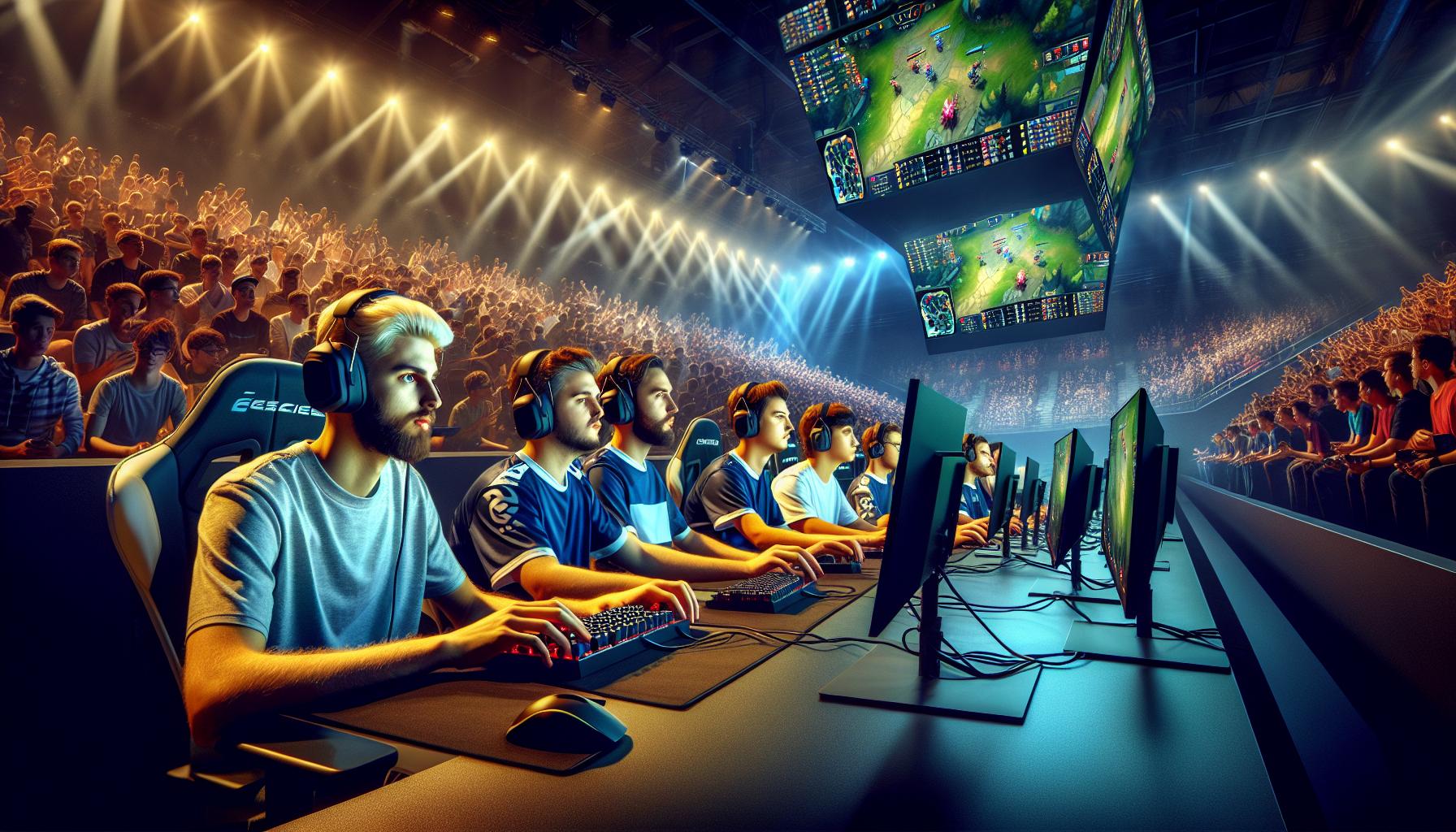Key Takeaways
- Esports Growth: Esports has evolved from informal arcade competitions in the 1970s to a major global industry, attracting millions of fans and professionals alike.
- Diverse Games and Competitions: Popular genres include MOBA games like League of Legends and Dota 2, and FPS games like Counter-Strike: Global Offensive and Call of Duty, appealing to a vast audience.
- Significant Market Value: The global esports market was valued at approximately $1.5 billion in 2022, with projections suggesting it may exceed $3.5 billion by 2027 due to rising sponsorship and media rights revenues.
- Wide Player Demographics: Esports players predominantly range from 18 to 34 years old, with nearly 30% being female participants, reflecting a growing diversity in gaming communities.
- Cultural Impact: Esports fosters social interactions and community bonding, comparable to traditional sports, while streaming platforms like Twitch enhance the gaming experience and support content creation careers.
- Economic Benefits: The industry generates significant revenue through sponsorships, merchandise sales, and live event ticket sales, contributing to job creation and broader market growth.
Esports has rapidly transformed from a niche hobby into a global phenomenon, captivating millions of fans and players alike. With thrilling competitions streamed live and massive prize pools at stake, it’s no wonder that esports is often compared to traditional sports. This dynamic landscape is not just about gaming; it’s a cultural movement that’s reshaping entertainment as we know it.
As the industry continues to grow, understanding the key facts about esports becomes essential. From its origins and the rise of competitive gaming to the influence of technology and sponsorship, there’s much to explore. Whether someone is a seasoned gamer or a curious newcomer, diving into the world of esports reveals a vibrant community and a wealth of opportunities waiting to be discovered.
Facts About Esports
Esports encompasses professional competitive gaming, attracting millions of fans and players worldwide. Esports events feature skilled players competing in popular video games like League of Legends, Dota 2, and Counter-Strike: Global Offensive, drawing parallels to traditional sports.
Esports has roots tracing back to the 1970s, with early competitions around arcade games. The 1990s brought organized tournaments, fueling growth. By the 2000s, streaming platforms like Twitch gained traction, enhancing visibility and engagement within the community.
Technology plays a crucial role in the expansion of esports. High-speed internet, advanced gaming consoles, and quality streaming services contribute to the accessibility and appeal of esports. These elements enable seamless viewing experiences for fans. Sponsorship and media rights further bolster the industry, attracting significant investments.
Today’s esports landscape features diverse competitions, including tournaments, leagues, and exhibition matches. Players often compete for substantial cash prizes, sometimes reaching millions. Esports organizations sponsor teams, providing resources for training and competition.
The global esports community thrives with millions of viewers, including audiences across different demographics. Major events fill arenas, showcasing live gameplay and engaging fan experiences. Social media and online platforms foster connections among fans, players, and organizations, promoting discussions and interactions.
Esports continues to evolve, driven by innovations in technology, format changes, and audience engagement strategies. This dynamic environment presents opportunities for gamers, sponsors, and fans to explore the ever-expanding domain of competitive gaming.
Historical Background

Esports has a rich history that highlights its journey from simple arcade competitions to a globally recognized industry. Significant milestones mark the emergence of competitive gaming and the evolution of esports tournaments.
Emergence of Competitive Gaming
Competitive gaming began in the 1970s with informal competitions among players of arcade games like Pong and Space Invaders. In 1980, Atari organized the first large-scale video game competition, attracting over 10,000 participants. The 1990s introduced online gaming, enabling players to compete in games like Quake and StarCraft. This access set the stage for more structured competition, leading to the formation of esports organizations such as the Cyberathlete Professional League (CPL) and the World Cyber Games (WCG).
Evolution of Esports Tournaments
The evolution of esports tournaments gained momentum in the late 1990s and early 2000s. In 1997, the Red Annihilation tournament for Quake saw the champion win a housing unit as a prize, symbolizing the growth of prize offerings in gaming events. The introduction of games like Counter-Strike and Warcraft III further diversified the tournament landscape. In 2003, Major League Gaming (MLG) emerged, becoming a leader in organizing professional esports tournaments.
By the 2010s, tournaments evolved into massive events, with the International for Dota 2 offering over $40 million in prize money by 2019. Major tournaments now fill arenas globally, attracting thousands of spectators and millions of online viewers, illustrating how esports competitions shifted into mainstream entertainment.
Key Statistics

Esports has become a significant industry with impressive statistics highlighting its growth and diversity. Various aspects showcase the demographic reach and financial potential within this competitive gaming landscape.
Player Demographics
- Age Distribution: The majority of esports players range from 18 to 34 years old, with nearly 50% falling within this bracket. Many younger players, aged 13 to 17 years, also actively participate.
- Gender Representation: Female esports participants account for roughly 30% of players. This percentage reveals a growing interest among women, contributing to a more balanced environment.
- Geographic Spread: North America and Asia represent key regions in esports, with China leading in player participation and the gaming market. Europe also exhibits strong engagement, especially in countries like Germany and the UK.
- Market Value: The global esports market reached an estimated $1.5 billion in 2022, indicating robust financial growth. Projections suggest this figure could surpass $3.5 billion by 2027.
- Sponsorships: Sponsorship revenue constituted nearly 60% of esports income in 2022. Major brands invest heavily in esports, attracted by its expanding audience.
- Media Rights: Media rights contributed more than $300 million to the esports ecosystem, underscoring the increasing interest from broadcasters and streaming platforms for exclusive content.
- Event Revenue: Live tournament events generated approximately $40 million in ticket sales and merchandise in 2022, showcasing the appeal of in-person experiences to fans.
These statistics illustrate the vibrant and rapidly evolving nature of esports, reflecting its wide-ranging player demographics and significant revenue potential.
Popular Esports Titles

Esports features a variety of popular titles, each attracting different audiences and providing unique gameplay experiences. The main categories include MOBA games and FPS games.
MOBA Games
MOBA (Multiplayer Online Battle Arena) games are a cornerstone of esports. Titles like League of Legends and Dota 2 lead this genre, showcasing team-based strategic gameplay.
- League of Legends: Developed by Riot Games, it has a player base exceeding 100 million monthly active users. The annual World Championship features teams competing for a prize pool that often exceeds $6 million.
- Dota 2: Created by Valve Corporation, Dota 2 is known for its high-stakes competition. The International tournament reached a record prize pool of over $40 million in 2019, highlighting its significance in the esports sphere.
These games require teamwork, efficient strategies, and high-level skill, making them popular among both players and viewers.
FPS Games
FPS (First-Person Shooter) games dominate another segment of the esports landscape. Counter-Strike: Global Offensive (CS:GO) and Call of Duty exemplify this genre.
- Counter-Strike: Global Offensive: Known for its tactical gameplay, CS:GO has a fervent following. Major tournaments, like ESL One, attract teams from around the world and offer substantial prize pools, with top events focusing on $1 million prizes.
- Call of Duty: This franchise features a competitive league model, the Call of Duty League, that operates annually. The league includes franchise teams that compete in season championships, showcasing intense gameplay and drawing large audiences.
Both MOBA and FPS titles contribute significantly to the diversity and popularity of esports, appealing to a broad range of players and fans.
Impact on Society
Esports significantly influences society through cultural and economic dimensions. These impacts reflect the growing presence of competitive gaming and its integration into everyday life.
Cultural Influence
Esports cultivates a unique culture that merges entertainment, social interaction, and community. Players and fans share a bond through shared interests in games, fostering friendships across geographical boundaries. Events like the League of Legends World Championship attract millions of viewers, creating communal experiences reminiscent of traditional sporting events. Moreover, game streaming platforms like Twitch enable content creation, allowing gamers to showcase skills and build careers. This culture encourages diversity, with increased female participation and representation among players and creators, leading to broader acceptance of gaming as a legitimate pursuit.
Economic Implications
Esports offers notable economic benefits, contributing to job creation and revenue generation. The industry supports various sectors, including streaming services, merchandise sales, and event management. Sponsorship deals and advertising investments play a crucial role in its financial landscape, with companies like Intel and Coca-Cola investing heavily in esports partnerships. In 2022, the global esports market reached approximately $1.5 billion, with projections suggesting continued growth to over $3.5 billion by 2027. Additionally, live tournaments generate significant ticket sales and merchandise revenue, with an estimated $40 million recorded in 2022. These economic implications demonstrate how esports not only entertains but also promotes vibrant markets and employment opportunities within the industry.
Landscape Of Entertainment And Competition
Esports has undeniably transformed the landscape of entertainment and competition. Its journey from humble beginnings to a billion-dollar industry showcases the passion and dedication of players and fans alike. The vibrant community continues to grow as technology advances and new titles emerge.
With significant investments and sponsorships driving its expansion esports is set to become an even more integral part of global culture. As audiences engage with live events and streaming platforms the future looks bright for competitive gaming. The impact of esports reaches far beyond the screen influencing social interactions and economic opportunities around the world.